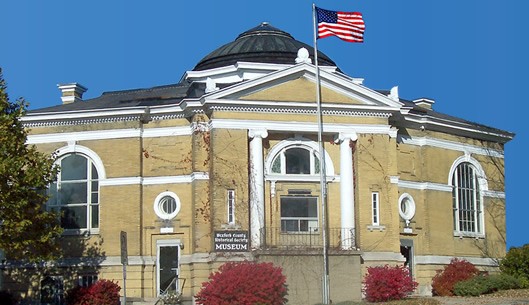Wexford County Museum / Carnegie Library
Introduction
Text-to-speech Audio
Images
Wexford County Historical Society Museum / Carnegie Library as it appears today.

Backstory and Context
Text-to-speech Audio
HISTORIC TIMELINE
- March 1903 - Carnegie Foundation agrees to donate $15,000 towards the library building. As part of the agreement, the City of Cadillac had to match the building fund, provide the building site, and pledge to support the library at a maintenance cost of $1,500 per year..
- June 1904 - Jacob and Wellington Cummer and their wives donate the site for the new library.
- July 1904 - The City of Cadillac accepts the Carnegie Foundation offer and passes a resolution pledging the annual maintenance support.
- August 1904 - Carnegie Library Building Committee is established.
- Fall 1904 - The Building Committee selects Scheurmann & Merriam Architects of Saginaw to design the building, and Freuchtel Construction Company of Saginaw to be the building contractor.
- May 11, 1905 - Ground is broken by excavator J.B. Gardner
- September 7, 1906 - Cadillac Public Library has its grand opening and over 1,000 people attend the event. Total cost of the project is $30,000.
- 1950s - The two-story concrete garage is added on the west side to house the bookmobile.
- 1969 - The Cadillac Public Library outgrows its original structure and moves to a new building on Lake Street.
- 1969 to 1977 - The Cadillac Police Department occupies the former Cadillac Public Library building. When they move out, the vacant building is considered for demolition.
- September 1977 - The City of Cadillac accepts the Wexford County Historical Society's proposal to designate the building a historical site and provide them with a lease to operate the building as a county museum.
- Summer 1978 - The Wexford County Historical Society Museum opens to the public.
- June 3, 1983 - The former Cadillac Public Library is designated a State Historical Site by the Michigan Historical Commission.
- May 2007 - The former Cadillac Public Library is listed on The National Register of Historic Places.
- September 2009 - Restoration work on the copper dome is completed. In October 2010, the contractors, Buist Sheet Metal, received a construction excellence award from the Associated Builders and Contractors of Western Michigan, which considered the work an example of "true old fashioned craftsmanship."
Today at the Museum you will see... Period clothing displays; Main Street Store displays; Home displays including nursery, kitchen, dining room, and parlor; Research Room including plat books, maps,school year books, city directories, and local and state history books and computer; School Memories; Michigan Bell Telephone switchboard; Barber Shop and Watch Shop; Local Dentist and Doctor office; Vietnam Mural by local artist; Military displays; Lumbering, railroad & farming equipment; Firehouse display; One-Room Schoolhouse;Native American display; Banking and Industry display; Ad Wolgast display; Doll Collection; Interactive Children's area.
